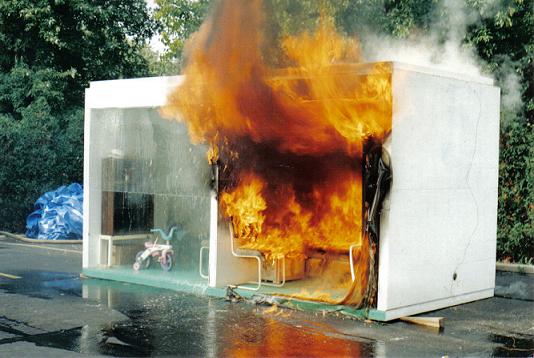Most often when a new customer comes to us having used a previous facilities maintenance software they already have a list of their preventive maintenance tasks that they wish to carry over. Unfortunately, the same can not be said for those coming to us with no previous software exposure. In most cases, those coming from a paper-based method lack the organization or formal process that comes along with one who is forced to use a software package. Considering the amount of new users out there who don’t have a formalized list of Preventive Maintenance Tasks, we have decided to start a series outlining the must-do preventive maintenance tasks for most locations.

Side-by-side fire sprinkler fire test proving successful
Before we start, it is important to state that these tasks are mere suggestions in regards to frequency and that you should still check with your local bi-laws to confirm regulations. Let’s begin our series with one of the most important preventive maintenance categories found related to building safety, Fire related tasks.
Extinguishers
The most often repeated task done related to Fire Safety is the Fire Extinguishers Test which should occur at least once per month. A simple procedure that should take you though the process of checking the proper gauge reading of the extinguisher and providing some kind of record keeping. In some cases, Extinguishers may need to be certified every month by an inspector. A log of the inspection usually needs to kept near the Extinguisher itself to allow for quicker inspections in the subsequent months.
Sprinklers
Fire Sprinklers require more attention and differ on what needs to be done to complete the preventive maintenance task. Backflow prevention tests should occur on a monthly basis and once every quarter, one should have the Fire Sprinkler System inspected and certified by a professional. During the inspection process the most common steps for inspections are as follows:
- Place alarms on standby
- Actuate valve to ensure supervisory signals are received
- Flow water to ensure flow switches are functioning
- Flush line for backflow prevention
- Make any repairs needed through qualified repair technician
- Flush main line to clear out backflow preventer
- Check for physical damage
- Inspect each head from floor level for damage, foreign material, paint, leakage, etc
- Inspect for proper number and type of spare sprinkler heads and wrench is available
- Visually inspect all exposed components for damage, etc.
Fire Drills
Every quarter your facility to should execute a full-on fire drill test which allows everyone in the building to know what is expected of them in case of a fire. Performing the fire drill includes verification of the fire alarm system which should be fully operational during the drill. Here are the most comment steps:
- Introduce fire indicator to the group (towel, cone, etc.)
- Familiarize staff with the annunciator panel (if applicable). Show staff how panel relates to physical building and demonstrate how lights correspond to triggers in various building locations
- Train staff on operation of door latches (both positive and roller latches)
- Inform fire station / monitoring company of the test
- Place commonly recognized fire indicator in the zone of the trigger device that will be activated
- Rescue resident, check bathroom if door is closed. Close room door when exiting
- Test the system by activating a smoke detector, pull station, or other trigger in the proper zone
- Maintenance staff should verify activation at the fire department / monitoring company
- Staff in the zone of origin should systematically inspect each room to find the fire and ensure doors are closed
- Notify residents of the drill, if applicable document who the residents were that were involved in the evacuation, and where they were evacuated to
- Staff in other zones should calm residents, let them know it's only a drill, and close the doors until the drill is over
- After fire is located, suspend the drill, silence the alarms, and notify the facility that the test is concluded
- Have maintenance staff reset the alarm system
- Call fire station / monitoring company and let them know the test is concluded
Verify Operation of the Alarm System (during drill)
- Confirm that annunciator panel(s) indicated the proper zone of the fire
- Conduct a walk-through inspection checking the following items
- Strobes and alarms can be seen and heard in all areas of the building
In Conclusion
Make sure you ask the staff for feedback on drill, note the time of drill and staff involved. Also note any problems or discrepancies you may have encountered (keep in mind that the primary purpose of the drill is to find flaws and make improvements) and finally list recommendations for future drills and training.
Check with us soon for more must-do preventive maintenance tasks all of which can be automated through Maintenance Care’s web-hosted facility maintenance software.









